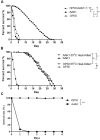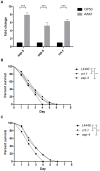A Disease Model of Muscle Necrosis Caused by Aeromonas dhakensis Infection in Caenorhabditis elegans
- PMID: 28101079
- PMCID: PMC5209350
- DOI: 10.3389/fmicb.2016.02058
A Disease Model of Muscle Necrosis Caused by Aeromonas dhakensis Infection in Caenorhabditis elegans
Abstract
A variety of bacterial infections cause muscle necrosis in humans. Caenorhabditis elegans has epidermis and bands of muscle that resemble soft-tissue structures in mammals and humans. Here, we developed a muscle necrosis model caused by Aeromonas dhakensis infection in C. elegans. Our data showed that A. dhakensis infected and killed C. elegans rapidly. Characteristic muscle damage in C. elegans induced by A. dhakensis was demonstrated in vivo. Relative expression levels of host necrosis-associated genes, asp-3, asp-4, and crt-1 increased significantly after A. dhakensis infection. The RNAi sensitive NL2099 rrf-3 (pk1426) worms with knockdown of necrosis genes of crt-1 and asp-4 by RNAi showed prolonged survival after A. dhakensis infection. Specifically knockdown of crt-1 and asp-4 by RNAi in WM118 worms, which restricted RNAi only to the muscle cells, conferred significant resistance to A. dhakensis infection. In contrast, the severity of muscle damage and toxicity produced by the A. dhakensis hemolysin-deletion mutant is attenuated. In another example, shiga-like toxin-producing enterohemorrhagic E. coli (EHEC) known to elicit toxicity to C. elegans with concomitant enteropathogenicty, did not cause muscle necrosis as A. dhakensis did. Taken together, these results show that Aeromonas infection induces muscle necrosis and rapid death of infected C. elegans, which are similar to muscle necrosis in humans, and then validate the value of the C. elegans model with A. dhakensis infection in studying Aeromonas pathogenicity.
Keywords: Aeromonas dhakensis; Caenorhabditis elegans; disease model; infection; muscle necrosis.
Figures






Similar articles
-
RIOK-1 Is a Suppressor of the p38 MAPK Innate Immune Pathway in Caenorhabditis elegans.Front Immunol. 2018 Apr 17;9:774. doi: 10.3389/fimmu.2018.00774. eCollection 2018. Front Immunol. 2018. PMID: 29719537 Free PMC article.
-
UvrY is required for the full virulence of Aeromonas dhakensis.Virulence. 2020 Dec;11(1):502-520. doi: 10.1080/21505594.2020.1768339. Virulence. 2020. PMID: 32434424 Free PMC article.
-
A comparative study of clinical Aeromonas dhakensis and Aeromonas hydrophila isolates in southern Taiwan: A. dhakensis is more predominant and virulent.Clin Microbiol Infect. 2014 Jul;20(7):O428-34. doi: 10.1111/1469-0691.12456. Epub 2013 Dec 16. Clin Microbiol Infect. 2014. PMID: 24237662
-
Evaluating Virulence and Pathogenesis of Aeromonas Infection in a Caenorhabditis elegans Model.J Vis Exp. 2018 Dec 20;(142). doi: 10.3791/58768. J Vis Exp. 2018. PMID: 30614490
-
Aeromonas dhakensis, an Increasingly Recognized Human Pathogen.Front Microbiol. 2016 May 27;7:793. doi: 10.3389/fmicb.2016.00793. eCollection 2016. Front Microbiol. 2016. PMID: 27303382 Free PMC article. Review.
Cited by
-
Corynebacterium diphtheriae Virulence Analyses Using a Caenorhabditis elegans Model.Curr Protoc Microbiol. 2020 Sep;58(1):e109. doi: 10.1002/cpmc.109. Curr Protoc Microbiol. 2020. PMID: 32658384 Free PMC article.
-
An Update on the Genus Aeromonas: Taxonomy, Epidemiology, and Pathogenicity.Microorganisms. 2020 Jan 17;8(1):129. doi: 10.3390/microorganisms8010129. Microorganisms. 2020. PMID: 31963469 Free PMC article. Review.
-
RIOK-1 Is a Suppressor of the p38 MAPK Innate Immune Pathway in Caenorhabditis elegans.Front Immunol. 2018 Apr 17;9:774. doi: 10.3389/fimmu.2018.00774. eCollection 2018. Front Immunol. 2018. PMID: 29719537 Free PMC article.
-
Remedial Treatment of Corroded Iron Objects by Environmental Aeromonas Isolates.Appl Environ Microbiol. 2019 Jan 23;85(3):e02042-18. doi: 10.1128/AEM.02042-18. Print 2019 Feb 1. Appl Environ Microbiol. 2019. PMID: 30478230 Free PMC article.
-
A gonadal gap junction INX-14/Notch GLP-1 signaling axis suppresses gut defense through an intestinal lysosome pathway.Front Immunol. 2023 Oct 19;14:1249436. doi: 10.3389/fimmu.2023.1249436. eCollection 2023. Front Immunol. 2023. PMID: 37928537 Free PMC article.
References
LinkOut - more resources
Full Text Sources
Other Literature Sources
Research Materials

